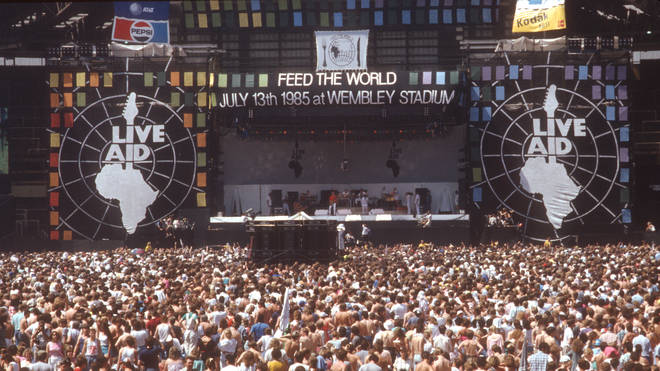13th July 2020
On the surface Live Aid may seem to be a success story, one which the West can be proud of. As we delve deeper however, we see that there is much that is problematic about Live Aid and what it represents…

Today marks 35 years since the legendary Live Aid concert on 13th July 1985. This global fundraising campaign, organised by Bob Geldof and Midge Ure, is a landmark moment in the contemporary consciousness of many across the world. Many will recall where they were and who they were with on that night. The event, designed to raise funds for the ongoing famine in Ethiopia, consisted of two live concerts in London and Philadelphia streamed live to an audience of est. 1.9 billion people in 150 nations and a live audience of over 160,000 across the two locations. Almost 40% of the world’s population are thought to have watched the live broadcast. It raised an est. $127 million for the cause and put humanitarian issues firmly on the agenda for both individuals and governments in the West.
There remains however, considerable controversy as to material success of the campaign, both immediately in tackling the crisis in Ethiopia, and in improving the lives of people on the wider continent in the long term. Despite Médecins Sans Frontières raising concerns, Live Aid’s organisers liaised directly with the Ethiopian government and they received the majority of the aid. Human Right’s Watch have since argued that over half of the famine’s deaths were the result of ‘human rights abuses’ by Derg leader Mengistu Haile Mariam, including the restriction of food supplies as part of local counter-insurgency strategies and ‘social transformation’ projects. Estimates for the number of fatalities range from 400,000 to 1.2 million people. A 2010 BBC report also offered evidence that aid was used to the purchase of arms from the Soviet Union and escalated the regional violence, although this was refuted by the Band Aid Trust and an apology was issued.
The fundraiser ushered in an era of what Dambisa Moyo describes as ‘orchestrated world-wide pity’ for Africa and its people. Public fundraising, far from being something for emergency relief, became a long-term project. Well into the 2000s and even today, we see ostensibly outraged and moved celebrities (who are almost exclusively white) sacrificing their valuable time and luxurious lifestyles to be filmed with starving Black African children, with swollen bellies and flies around their eyes who, for some reason, are always infinitely happier after a minor reality TV star arrives. These painful stereotypes are the go-to format for the likes of Oxfam, Water Aid and Save the Children.
For some, they may seem awkward but ultimately harmless: “these charities do it so they can raise money for them so it’s okay, it makes sense”, I can hear the parents and grandparents saying. But no, they are not harmless. They capitalise off our need to be the superior ‘White Saviours’, to ‘rescue’ Africa, which we homogenise and stereotype as a singular place of famine, disease and poverty and not one of emerging opportunity. Throughout these campaigns, we are constantly exposed to hardcore poverty porn designed to generate enough sympathy and guilt from us to donate funds to large multinational organisations. In doing so, we dehumanise and belittle the very people we are trying to help. We position ourselves as voyeurs, observing events which we, in all likelihood, will never experience and yet continue to claim we know how to solve.
Whilst emergency aid can relieve crises in the short term, long-term aid can create dependency and worsen economic and social outcomes. In many respects, long-term development aid is yet another colonial legacy, fundamentally rooted in the belief that Western ideologies are universal and superior, that strategies used to initiate growth and prosperity in the US and elsewhere must and should be implemented in Africa and Asia. Since 1960, Western nations have donated over $1 trillion of development aid to African nations. This is the equivalent of giving roughly $1000 to every African alive today and yet, 1 in 3 Africans still live below the global poverty line of $1.90 a day and constitute 70% of the world’s poorest people. Meanwhile, the share of global wealth of the top 1% continues to rise and now stands at 44%. We have to ask ourselves whether the self-gratification we receive from our donation and the free positive publicity celebrities receive for their ‘selfless’ charity work does more to benefit us than it does ‘the starving Africans’.
Many will say, “isn’t it better to do something than nothing?” I say, yes of course, but consider the terms on which you do this. Look to a country and its people for solutions and not to foreign multinational corporations or charities, which all have alternative interests. If you want to donate or loan funds, search for local, targeted projects run by domestic organisations with local work forces and not oversees volunteers. When purchasing goods and services try and ensure you do so ethnically and sustainably. Seek out Fairtrade alternatives and do your research when you travel. Pick family-run and locally owned hotels and restaurants, not multinational chains and book directly and not through a travel agent. Your everyday choices make a difference. In doing this, you engage through business, creating lasting opportunities and empowering individuals. The relationship is not one of hierarchy in which you are ‘giving’ or exploiting but instead exchanging as equals.
By @cocohuggins for The Geographer Journalist